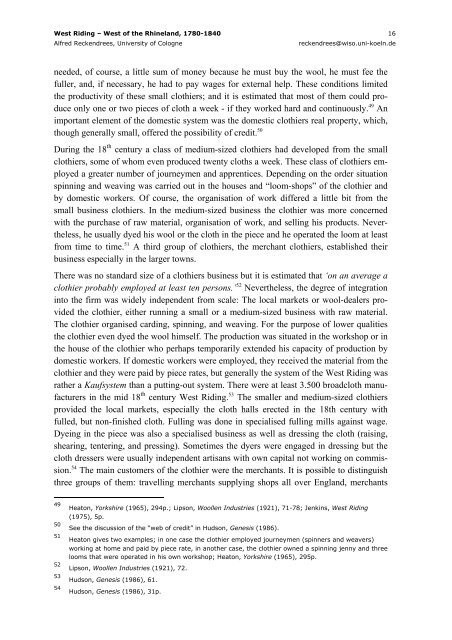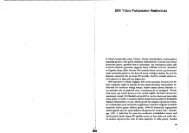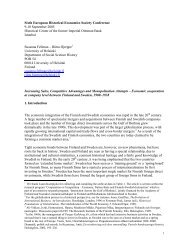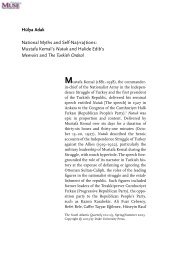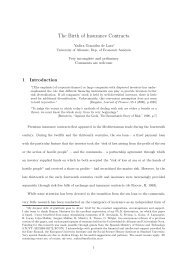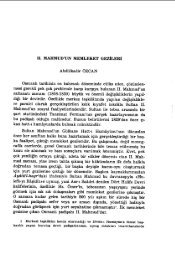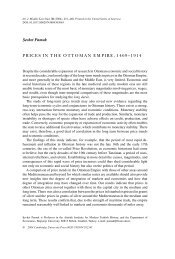West Riding – Western Rhineprovince, 1790-1840: Diverse Paths to ...
West Riding – Western Rhineprovince, 1790-1840: Diverse Paths to ...
West Riding – Western Rhineprovince, 1790-1840: Diverse Paths to ...
Create successful ePaper yourself
Turn your PDF publications into a flip-book with our unique Google optimized e-Paper software.
<strong>West</strong> <strong>Riding</strong> <strong>–</strong> <strong>West</strong> of the Rhineland, 1780-<strong>1840</strong> 16<br />
Alfred Reckendrees, University of Cologne reckendrees@wiso.uni-koeln.de<br />
needed, of course, a little sum of money because he must buy the wool, he must fee the<br />
fuller, and, if necessary, he had <strong>to</strong> pay wages for external help. These conditions limited<br />
the productivity of these small clothiers; and it is estimated that most of them could produce<br />
only one or two pieces of cloth a week - if they worked hard and continuously. 49 An<br />
important element of the domestic system was the domestic clothiers real property, which,<br />
though generally small, offered the possibility of credit. 50<br />
During the 18 th century a class of medium-sized clothiers had developed from the small<br />
clothiers, some of whom even produced twenty cloths a week. These class of clothiers employed<br />
a greater number of journeymen and apprentices. Depending on the order situation<br />
spinning and weaving was carried out in the houses and “loom-shops” of the clothier and<br />
by domestic workers. Of course, the organisation of work differed a little bit from the<br />
small business clothiers. In the medium-sized business the clothier was more concerned<br />
with the purchase of raw material, organisation of work, and selling his products. Nevertheless,<br />
he usually dyed his wool or the cloth in the piece and he operated the loom at least<br />
from time <strong>to</strong> time. 51 A third group of clothiers, the merchant clothiers, established their<br />
business especially in the larger <strong>to</strong>wns.<br />
There was no standard size of a clothiers business but it is estimated that ‘on an average a<br />
clothier probably employed at least ten persons.’ 52 Nevertheless, the degree of integration<br />
in<strong>to</strong> the firm was widely independent from scale: The local markets or wool-dealers provided<br />
the clothier, either running a small or a medium-sized business with raw material.<br />
The clothier organised carding, spinning, and weaving. For the purpose of lower qualities<br />
the clothier even dyed the wool himself. The production was situated in the workshop or in<br />
the house of the clothier who perhaps temporarily extended his capacity of production by<br />
domestic workers. If domestic workers were employed, they received the material from the<br />
clothier and they were paid by piece rates, but generally the system of the <strong>West</strong> <strong>Riding</strong> was<br />
rather a Kaufsystem than a putting-out system. There were at least 3.500 broadcloth manufacturers<br />
in the mid 18 th century <strong>West</strong> <strong>Riding</strong>. 53 The smaller and medium-sized clothiers<br />
provided the local markets, especially the cloth halls erected in the 18th century with<br />
fulled, but non-finished cloth. Fulling was done in specialised fulling mills against wage.<br />
Dyeing in the piece was also a specialised business as well as dressing the cloth (raising,<br />
shearing, tentering, and pressing). Sometimes the dyers were engaged in dressing but the<br />
cloth dressers were usually independent artisans with own capital not working on commission.<br />
54 The main cus<strong>to</strong>mers of the clothier were the merchants. It is possible <strong>to</strong> distinguish<br />
three groups of them: travelling merchants supplying shops all over England, merchants<br />
49<br />
Hea<strong>to</strong>n, Yorkshire (1965), 294p.; Lipson, Woollen Industries (1921), 71-78; Jenkins, <strong>West</strong> <strong>Riding</strong><br />
(1975), 5p.<br />
50<br />
See the discussion of the “web of credit” in Hudson, Genesis (1986).<br />
51 Hea<strong>to</strong>n gives two examples; in one case the clothier employed journeymen (spinners and weavers)<br />
working at home and paid by piece rate, in another case, the clothier owned a spinning jenny and three<br />
looms that were operated in his own workshop; Hea<strong>to</strong>n, Yorkshire (1965), 295p.<br />
52 Lipson, Woollen Industries (1921), 72.<br />
53 Hudson, Genesis (1986), 61.<br />
54 Hudson, Genesis (1986), 31p.


